Iron Age residents of Judea regularly ate non-Kosher fish like catfish despite it being ‘strictly forbidden’ under Jewish dietary laws, a new archaeological study found.
Researchers from Israel’s Ariel University examined fish bones dating back thousands of years, found at 30 archaeological sites in the country, to uncover the dietary secrets.
The team found no evidence of people following rules banning the eating of fish species without scale or fin until the Roman era in the 6th century CE.
The findings shed fresh light on the origin of Old Testament dietary laws still observed by Jewish people today, that mythology and religious history suggest were first introduced by Moses in the 12th century BCE.
The Torah, including dietary rules around forbidden foods and slaughter practices, began to be written down during the Persian period of Judea in the 3rd century BCE.
A set of passages repeated twice forbids the eating of certain types of fish, but the origins and history of the seafood ban have not been explored in detail until now.
The Israeli team say their findings call for a rethink of assumptions that long-held traditions were the basis for the food laws outlined in the first five books of the Hebrew Bible, suggesting instead they were introduced when first written down.
Study author Dr Yonatan Adler told MailOnline that there is no archaeological evidence of Judeans following any of the dietary rules before the 3rd century BCE.
This is the anterior vertebra of a catfish excavated at Jerusalem used as part of a study into the eating habits of Iron age residents of Judea. It found they regularly eat non-Kosher fish like catfish despite it being ‘strictly forbidden’ under Jewish dietary laws

The team found no evidence of people following rules banning the eating of fish species without scale or fin until the Roman era in the 6th century CE. Pictured, a catfish (stock image)
The study, published in the journal Tel Aviv, reports an analysis of ancient fish bones from 30 archaeological sites in Israel and Sinai.
These dig sites date to the more than 2,000-year span from the Late Bronze Age until the end of the Byzantine period stretching into the 5th century BCE.
Study co-author Dr Yonatan Adler said the ban on finless and scaleless fish deviated from longstanding Judean dietary habits.
‘The Biblical writers appear to have prohibited this food despite the fact that non-kosher fish were often found on the Judean menu,’ Adler added.
‘There is little reason to think that an old and widespread dietary taboo lay at the root of this ban’.
The Book of Leviticus states: ‘Everything in the waters that does not have fins and scales is detestable to you’, while Deuteronomy decrees that ‘…whatever does not have fins and scales you shall not eat; it is unclean for you.’
In both pages, the references immediately follow a ban on ‘unclean’ pig which has received wide attention.
Adler told MailOnline that the issue of pigs in the dietary rules has been widely covered, but very little attention has been paid to the origins of the ban on non-scaled and non-finned fish from the paragraphs just before the one on pigs being unclean.
He said that there is a ‘black spot’ in their archaeological evidence, mainly from during the Persian period of Judea, but up until that point there is no evidence of people following the sort of dietary rules laid out in the Torah.
This could suggest the rules were not widely adopted until then, or even that the rules had not been laid out until that point.
According to Jewish tradition and religious leaders, the Torah, including dietary rules were accepted by 1.2 million Jewish people in 1275 BCE in Sinai, nearly 300 years after the earliest evidence uncovered as part of this new archaeological study.
However, Dr Adler told me to ‘forget everything you learned in Sunday school,’ as this study purely explored the physical evidence, not religious history.
‘The physical evidence, from archaeological digs, shows that until the Roman period people in Judea were still eating non-kosher fish.’
The first fish bones uncovered by the Israeli team date back to the start of the Late Bronze Age, about 1,550 BCE, suggesting non-finned fish including catfish, sharks, rays, skates, moray eels and sturgeons were widely eaten at that time.

The centrum of shark was excavated in the Israeli city of Ashkelon. The study, published in the journal Tel Aviv, reports an analysis of ancient fish bones from 30 archaeological sites in Israel and Sinai
In fact most of the fish bones uncovered by the team at the various dig sites were catfish, even as far as the 5th century BCE, when the lack of data begins.
Data begins to pick up again as the Roman era begins, when Judea was under Roman control – at this point people appeared to be following the kosher rules as the amount of catfish bones being discovered at sites from this era declined.
According to religious tradition the Torah was passed through down orally until the first scholars began to compile these thoughts in the 3rd century BCE.
Dr Adler said their work on non-Kosher fish is a tiny part of a much wider study tracking the physical history of Jewish tradition and religion – but through the food and life of the people, rather than leaders and scholars.
He said the origins and early history of the seafood ban have not been explored in detail by archaeologists or biblical scholars before this study.
The team set out to find when and how the ban first arose, and if it was predated by an earlier taboo practiced before the editing of the Old Testament passages.
They also sought to establish the extent to which the rule was obeyed.
Study co-author Professor Omri Lernau, of Haifa University, analysed thousands of fish remains from dozens of locations in Israel and Sinai, including Jerusalem.
At many Judean sites dating to the Iron Age, roughly between 1130 BCE and 586 BCE, including the Judean capital of Jerusalem, bones, including a ‘significant portion’ of non-kosher fish such as catfish, had been discovered.
This suggests that for a significant period after the Torah was said to be ‘widely accepted’ by religious scholars, fish without scale and fin were still being eaten.
Another key discovery was evidence of non-kosher fish consumption in Jerusalem during the Persian era from 539 BCE to 332 BCE.

The Israeli team say their findings call for a rethink of assumptions that long-held traditions were the basis for the food laws outlined in the first five books of the Hebrew Bible, suggesting instead they were introduced when first written down
But non-kosher fish bones were mostly absent from Judean settlements dating to the Roman era and later, with a few examples discovered.
The researchers noted that sporadic non-kosher fish remains from the later time may indicate ‘some degree of non-observance among Judeans’ but that generally the Kosher rules were being more widely observed.
Now they intend to analyse more fish from around the same era to establish when Judeans began to avoid eating scaleless fish, and how strictly the ban was observed.
The findings have been published in the journal Tel Aviv and are part of a wider study called the Origins of Judaism Archaeological Project.

